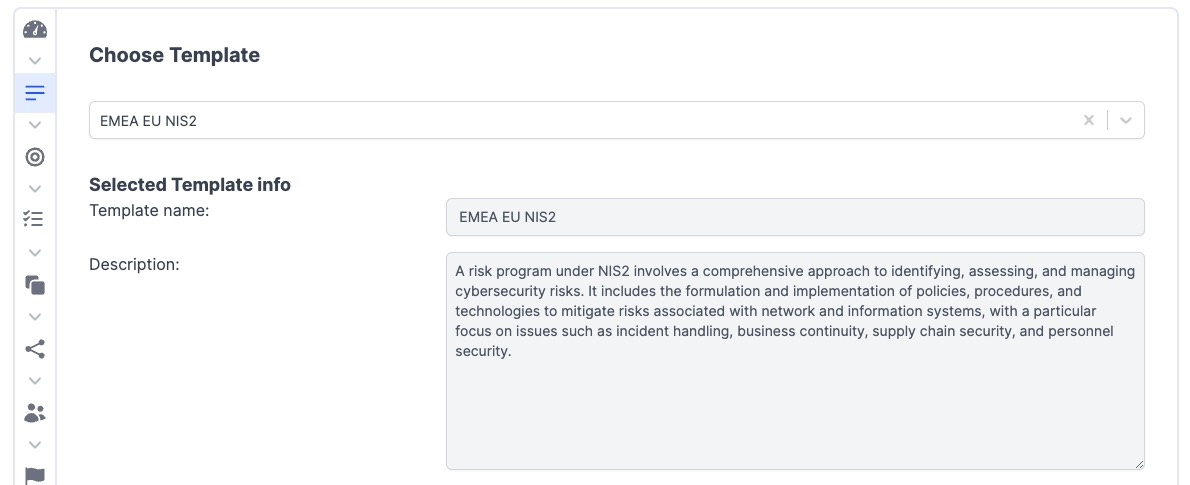Risk Templates

1. Introduction
Risk Templates are an essential tool within any organization aiming to streamline its risk management process. These pre-configured templates are designed to assist users in efficiently drafting risk documentation, ensuring consistency and saving valuable time. It includes predefined content, such as text, styles, formats, and a specific layout, which enables risks to be documented in a structured and uniform manner.
2. Key Sections of a Risk Template
Understanding the key sections enables users to create detailed and consistent risk management documents, promoting a strong and resilient approach to addressing organizational risks. Here is a summary:
2.1 Scope section
The scope section of a Risk Template defines the boundaries within which risk controls and management practices are applied. This information is recorded in the following fields:
Description: This section provides detailed information about the risk being addressed, offering insights into its nature and potential implications.
Risk Program Objective: This section clarifies the primary goal of the risk management effort, setting clear expectations for the outcomes of the risk process.
Consequences of Non-compliance: This section outlines the potential negative outcomes that may result from failure to comply with the risk management program.
2.2 Controls within the Risk Template
Each template contains a set of risk controls that have been carefully curated to help manage and mitigate risk within an organization. Risk controls are specific management actions or practices designed to identify, assess, and mitigate potential risks to an acceptable level. These controls play a critical role in identifying and managing risk by proactively addressing vulnerabilities and uncertainties in various aspects of the organization's operations.
By carefully implementing these risk controls, organizations can increase their resilience and minimize the potential negative impact of unforeseen events or disruptions on their overall performance and success.
These controls include a wide range of measures, from supplier evaluation and diversification to contractual agreements and contingency plans, all designed to ensure the integrity and continuity of the supply chain while maintaining operational stability.
Learn more about the idea behind Risk Controls check out this page.
3. Utilizing Risk Templates
Risk templates can be customized to meet specific organizational needs, providing flexibility while maintaining a structured framework for risk management. This standardized approach ensures that all users, regardless of their level of expertise, can effectively document and manage risks, contributing to the overall resilience and security of the organization.
Template name | Description | Source | Status |
|---|---|---|---|
NIS2 | ENISA NIS2 (Directive (EU) 2022/2555) |
| |
4. Frequently Asked Quesiton (FAQs)
Q1: What are Risk Templates, and how do they benefit organizations?
A1: Risk Templates are pre-configured tools designed to streamline an organization's risk management process. They provide predefined content, text, styles, formats, and layouts, helping users efficiently draft risk documentation with consistency and time-saving advantages. Risk Templates promote structured and uniform risk documentation within an organization, making risk management more effective and organized.
Q2: What are the key sections of a Risk Template, and why are they important?
A2: Understanding the key sections of a Risk Template is crucial for creating detailed and consistent risk management documents. The sections include:
Scope Section: Defines the boundaries for applying risk controls and management practices, including risk description, program objectives, and consequences of non-compliance.
Controls within the Risk Template: These are specific management actions or practices designed to identify, assess, and mitigate potential risks. They proactively address vulnerabilities and uncertainties in various aspects of the organization's operations, enhancing resilience and minimizing the negative impact of disruptions.
Q3: Can Risk Templates be customized to fit specific organizational needs?
A3: No, risk templates cannot be customized to your organization's unique requirements. This feature is on the roadmap and will follow later this year. We understand the need for this flexibility so that organizations can customize templates while still maintaining a structured risk management framework. Customization ensures that all users, regardless of their level of expertise, can effectively document and manage risk, contributing to the overall resilience and security of the organization.
Q4: Are there specific templates available for different types of risks or industries?
A4: Yes and no, organizations can choose different templates tailored to specific types of risks or industries upon request. These templates are designed to provide relevant content and guidance based on the nature of the risk or industry. Customizable templates are available to meet your specific needs. Currently, only the NIS2 template is available; more templates will follow later this year.
Q5: How do Risk Controls relate to Risk Templates?
A5: Risk Controls are a component within Risk Templates. They consist of specific management actions or practices designed to identify, assess, and mitigate risks. Risk Templates provide a structured framework for documenting and managing risks, and within each template, you will find a set of carefully curated Risk Controls to address specific risks effectively. The combination of Risk Templates and Risk Controls ensures a comprehensive approach to risk management.
